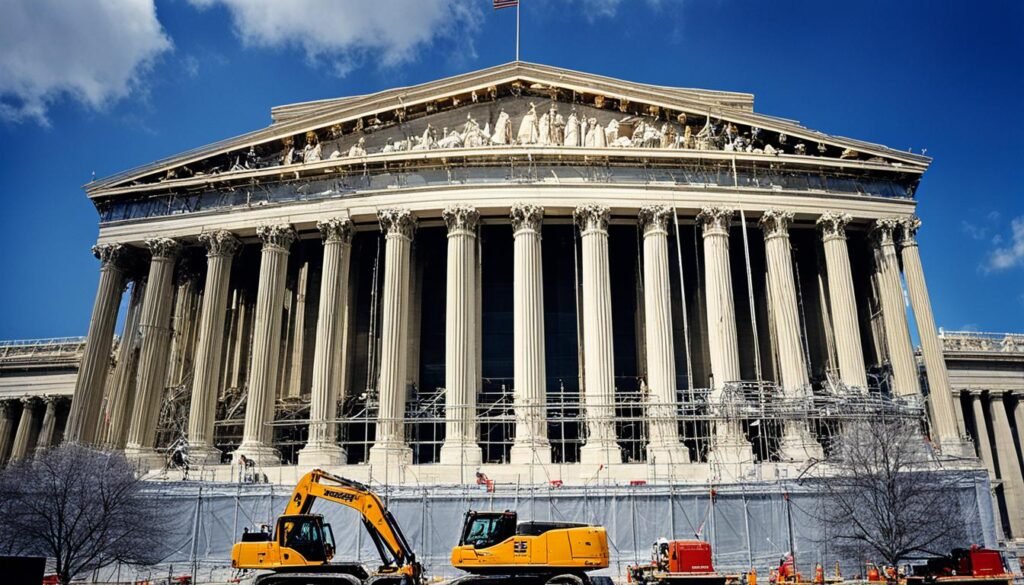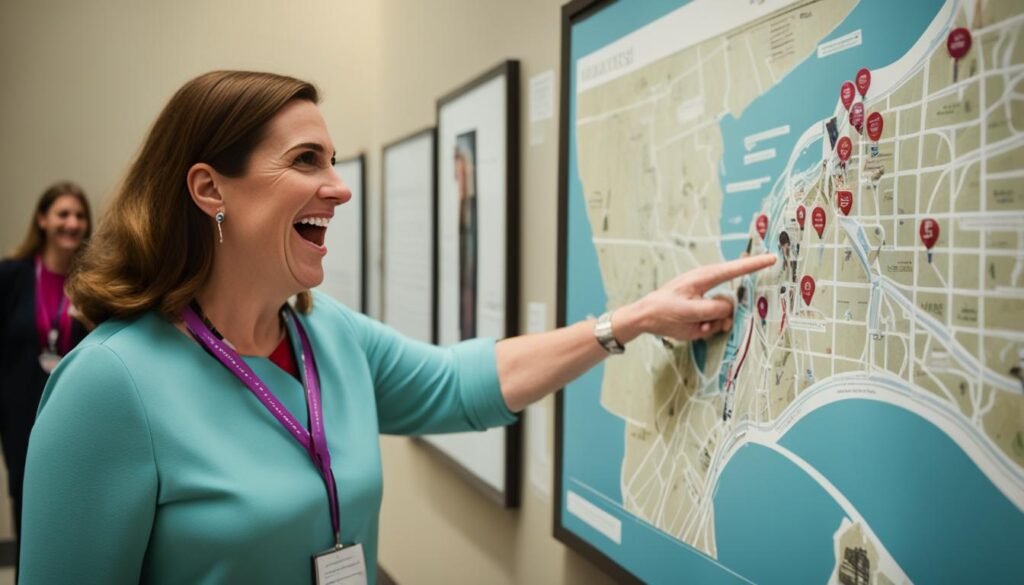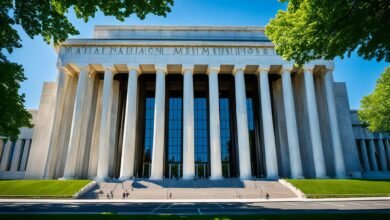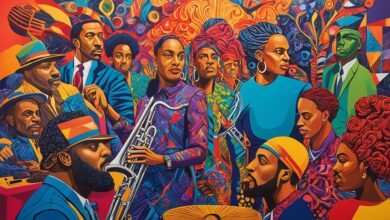Did you know the National Archives Museum in Washington, D.C. has over 10 billion pages of records? Including 13 million photos, 2.5 million maps, and 4.4 million still pictures. It's a key spot for American history, with our nation's crucial documents and artifacts. If you love history or just want to know more about the past, this museum is a must-see.
The museum is located at 701 Constitution Avenue, NW in Washington, D.C. It's run by the National Archives and Records Administration. Their goal is to gather, save, and share records that show our country's history. Thanks to its unique collection and detailed exhibits, the museum makes history come alive.
Visiting the National Archives, you'll see the Declaration of Independence, Constitution, and Bill of Rights. These documents are the heart of American democracy. They show the ideas our country was built on. You'll also find interesting exhibits on American history, including the Civil Rights Movement and our cultural heritage.
The best part? Getting in is free. This makes it easy for everyone to enjoy and learn from our history. Don't delay! Visit the National Archives Museum in Washington, D.C. now. Get ready to be drawn into the fascinating stories of the United States.
Hours and Location
Are you thinking about visiting the National Archives Museum in Washington, D.C.? Here's what you need to know about its hours and where it is.
Hours of Operation
- Open every day from 10:00 a.m. to 5:30 p.m.
- Last admission is 30 minutes before it closes.
- Closed on Thanksgiving Day and Christmas Day.
Conveniently Located
The National Archives Museum is at 701 Constitution Avenue, NW. It's between 7th and 9th Streets in Washington, D.C. There are two ways to get inside:
- The General Admission entrance is by Constitution Avenue and 9th Street.
- Find the Special Events entrance near Constitution Avenue and 7th Street.
Looking for the National Archives Research Center? It has its own door at 700 Pennsylvania Avenue, NW.
| Address | 701 Constitution Avenue, NW, Washington, D.C. |
|---|---|
| Entrances |
|
| Hours of Operation |
|
Reservations and Guidelines
You don't need to book ahead to enter the National Archives Museum in Washington, D.C., most times. But between March and Labor Day, we suggest making reservations. This helps you skip the long lines and have a better visit.
Even on the day you want to visit, you can book your spot. This is handy for last-minute plans. Remember, when it's really busy, spots might run out, so booking early is a good idea.
Booking in advance costs a nonrefundable $1.00 per ticket. But you can change your booking for free. This way, you can plan your visit without stress.
Every guest must pass a security check when they arrive. To make it easy, please bring only one bag per person.
Plan to spend at least 90 minutes at the museum. This gives you enough time to see everything. You won't want to rush through the amazing exhibits and historical treasures.
The museum is perfect for history lovers or anyone curious about America's story. You'll see important documents like the Declaration of Independence and the Constitution up close.
Book now to start your adventure at the National Archives Museum. It's a place where history is not just remembered, but comes to life.
Museum Renovation
The National Archives Museum is getting a big makeover. This includes updates to the galleries, learning center, and theater. The National Archives Foundation is working with them. It's a big chance to make things better for people who visit and keep history safe.
They plan to finish the work by summer 2025. This is right before the 250th birthday of the Declaration of Independence. The new features will use the latest technology and creative designs. This will help visitors connect with America's past in exciting, new ways.
Even though the Public Vaults are closed, there's still a lot to see. The National Archives Rotunda and other areas are open. They have different exhibits and artifacts for visitors to see.

Things to Do and See
At the National Archives Museum in Washington, D.C., there's much to see and do. You can check out different exhibits and take part in activities. The museum lets you take a deep dive into American history.
Rotunda for the Charters of Freedom
The Rotunda for the Charters of Freedom is a key attraction. It's where you see the Declaration of Independence, Constitution, and Bill of Rights. These documents are crucial to the US foundation.
David M. Rubenstein Gallery
In the David M. Rubenstein Gallery, the “Record of Rights” exhibit is featured. It looks at rights and freedoms over time. A 1297 Magna Carta is a special part of this, showing the evolution of legal rights.
Other Notable Exhibits
The museum also has other remarkable exhibits. If you're into social history, the “Power & Light: Russell Lee's Coal Survey” exhibit is worth seeing. It sheds light on coal miners' lives in the Great Depression. The East Rotunda Gallery's Featured Document Exhibit displays important historical papers.
“The National Archives Museum is a treasure trove of historical documents, offering visitors a unique opportunity to engage with America's past.”
Explore National Museum of African Art, D.C.
Programs and Special Activities
- Check out the museum's Calendar of Events to stay updated on the latest programs and special activities.
- Attend lectures, workshops, and interactive sessions focused on various aspects of American history.
- Participate in guided tours led by knowledgeable experts who provide valuable insights and context.
Museum Exhibitions
| Exhibition | Description |
|---|---|
| Rotunda for the Charters of Freedom | Houses the Declaration of Independence, Constitution, and Bill of Rights. |
| David M. Rubenstein Gallery | Features the “Record of Rights” exhibit, including a 1297 Magna Carta. |
| Power & Light: Russell Lee's Coal Survey | Explores coal mining during the Great Depression. |
| Featured Document Exhibit | Highlights significant historical documents from the National Archives' collection. |
Discover the US's rich history at the National Archives Museum. Explore the exhibits and connect with the past through historical documents.
Virtual Tour and Accessibility
Can't visit the National Archives Museum in Washington, D.C. in person? No problem! Take a virtual tour and dive into American history without leaving your home. This tour lets you explore the exhibits from wherever you are. It's great for those who can't travel or prefer to learn online. It offers a convenient and in-depth way to see the museum's treasures.
At the National Archives Museum, everyone is welcome. The museum ensures access for all visitors, sticking to ADA guidelines. Visitor services include ramps, accessible restrooms, and elevators to every floor. They also help those with visual impairments and offer assistive listening devices.
Don't forget to check out the museum's extras during your visit. The National Archives Store has loads of cool stuff, from books to unique American history gifts. Looking for a snack or a drink? Head to the Charters Café on weekdays.
Remember, the National Archives Museum encourages social distancing. While face masks are optional, they keep the place clean and safe for everyone. There are hand sanitizers all around, so you can visit without worry.
Ready for an adventure in history? Whether you're touring virtually or planning an in-person visit, the National Archives Museum is prepared to offer an unforgettable and accessible experience.
Parking and Transportation
Planning is key when visiting the National Archives Museum in Washington, D.C. There's no parking on-site, and spots nearby are hard to find.
Parking:
Driving? Several public parking garages are a short walk from the museum. These garages offer easy access and safe parking. To save time, check parking availability before you go.
Transportation:
Consider public transportation for an easy visit. The closest Metro stop is Archives-Navy Memorial-Penn Quarter. It's served by the Green and Yellow lines. The Metro avoids traffic and parking issues, making your trip better.
Taking public transport helps the planet too. It cuts down on traffic and harmful emissions.
Choose driving or public transport based on what works for you. Either way, planning ahead helps make your museum visit smooth and fun. Discover the museum's history and amazing exhibits without stress.
Group Visits
Are you planning to bring a group to the National Archives Museum in Washington, D.C.? Here's what you need to know for a great visit:
Arrival Time
Your group should arrive at the museum on time. The museum can't help latecomers catch up with their groups. To enjoy your visit fully, please plan to be on time.
School Groups and Students
School groups or students should split into smaller teams with their own chaperones. This helps in keeping an eye on everyone and makes the trip better for all. Keeping everyone safe and focused on learning is very important to us.
Guidelines for Behavior
We ask all our visitors, especially groups, to behave well inside the museum. If anyone acts out without a chaperone or disrupts others, they might have to leave. And it could affect their ability to come back later. Being respectful of the displays and other guests makes the visit nice for everyone.
Special Guidelines and Tips
We know some groups have special needs. Families, school groups, and military personnel can find helpful advice on our site. These tips are there to make their visit as good as it can be. It's full of helpful information for these visitors.
Founding Documents
One amazing place at the National Archives Museum is the Rotunda for the Charters of Freedom. Here, visitors can see the Declaration of Independence, Constitution, and Bill of Rights. These documents are key to understanding the United States' history and culture.
Rotunda for the Charters of Freedom
The Rotunda for the Charters of Freedom is a special area in the National Archives Museum. It keeps the Declaration of Independence, Constitution, and Bill of Rights safe.
The Declaration of Independence was signed on July 4, 1776. It announced the United States as an independent country. This document speaks about freedom and human rights.
The Constitution was confirmed in 1788. It's the highest law in the U.S. It explains how the government works and gives rights to the people.
The Bill of Rights includes the first ten changes to the Constitution. It promises key freedoms, like speech and religion. This shows the value of individual liberty and protects people's rights.
 Visit National Guard Memorial Museum, D.C.
Visit National Guard Memorial Museum, D.C.
Going to the Rotunda lets you connect with American democracy's beginnings. It helps you understand the country's main ideas better.
“We hold these truths to be self-evident, that all men are created equal…” – From the Declaration of Independence
Preservation and Significance
Keeping the founding documents safe is crucial for the National Archives Museum. The museum uses special methods to protect these precious items for the future.
These documents are more than history. They shape America's story and guide talks on democracy and rights.
Seeing the original texts in person shows the ideals and values that have built the U.S. for over 200 years.
The Founding Documents
| Document | Description | Location |
|---|---|---|
| Declaration of Independence | Adopted on July 4, 1776, declaring the United States' independence from Great Britain. | Link |
| Constitution | Ratified in 1788, establishing the framework of the U.S. government and outlining the rights of individuals and states. | Link |
| Bill of Rights | The first ten amendments to the Constitution, guaranteeing individual rights and limiting the power of the federal government. | Link |
Seeing the founding documents at the National Archives Museum connects you to America's roots. It makes you think about the ideas that made the U.S. what it is today.
If you love history or want to know more about U.S. democracy, visit the National Archives Museum's Rotunda for the Charters of Freedom. It's a chance to learn and appreciate the founding principles of the United States.
Reservations and Tours
Visiting the National Archives Museum in Washington, D.C. doesn't require a reservation. Yet, to avoid long waits and make your visit better, reserving your spot from March to Labor Day is best.
With a reservation, you get timed-entry tickets. They let you enter the museum in a specific 15-minute slot. You can book these from 10:00 a.m. to 4:30 p.m.
You can book up to six tickets per reservation, based on availability. This way, you and your friends or family can stay together while exploring.
Remember, everyone must go through security before entering. It keeps you and the museum's exhibits safe. Please arrive on time for your slot. If you're late, you might not get in.
Right now, guided tours aren't offered. But normally, they're available once a day. They provide a full view of the museum, including the famous Rotunda and the Public Vaults exhibit gallery.
| Reservation Details | Guided Tours |
|---|---|
| Reservation Requirement | Currently Unavailable |
| Timed-Entry Tickets | Once a Day |
| Reservation Availability | Rotunda for the Charters of Freedom and Public Vaults exhibit gallery |
Make your visit to the National Archives Museum better by booking ahead. Get your timed-entry tickets early. This ensures a smooth and memorable exploration of America's historical highlights.
Visitor Services Contact Information
If you need help or have questions, you can reach out to Visitor Services at visitorservices@nara.gov. The National Archives Museum provides contact details for groups like National Archives Foundation members or armed forces. Check the museum's website for this information.
Got questions about visiting the National Archives Museum in Washington, D.C.? Email visitorservices@nara.gov for help. The Visitor Services team will get back to you quickly.
Need to know about ticket booking or how we accommodate all visitors? Our staff is here to help you. We aim to make your time at the National Archives Museum both fun and educational.
Are you a member of the National Archives Foundation or in the armed forces? The museum's website has specific contact info for you. We are here to serve every visitor well.

Come see the National Archives Museum. Discover the incredible story of the United States for yourself!
Conclusion
The National Archives Museum in Washington, D.C., captures the essence of American history. It showcases presidential documents, historical exhibits, and archival methods. This museum is a great place to discover the heritage of the nation.
It offers both in-person visits and virtual tours. It's a haven of knowledge, perfect for those eager to learn about America's history.
Step into the Rotunda for the Charters of Freedom to explore America's foundational documents. Here, you can see the Declaration of Independence, Constitution, and Bill of Rights up close. These documents are key to understanding our nation's roots.
Seeing these important historical texts up close is an unforgettable experience. It brings to life the birth of the United States.
 Explore Anacostia Community Museum in D.C.
Explore Anacostia Community Museum in D.C.
The museum has galleries filled with displays on America's pivotal moments and influential figures. Exhibits range from the “Record of Rights” display, which includes a 1297 Magna Carta, to “Power & Light: Russell Lee's Coal Survey.” These exhibits are both fun and educational for all visitors.
The National Archives Museum in Washington, D.C., is an enriching experience for history buffs, students, and tourists. It offers a profound understanding of American history. So, whether you visit in person or take a virtual tour, it's an opportunity to explore the United States' past.




